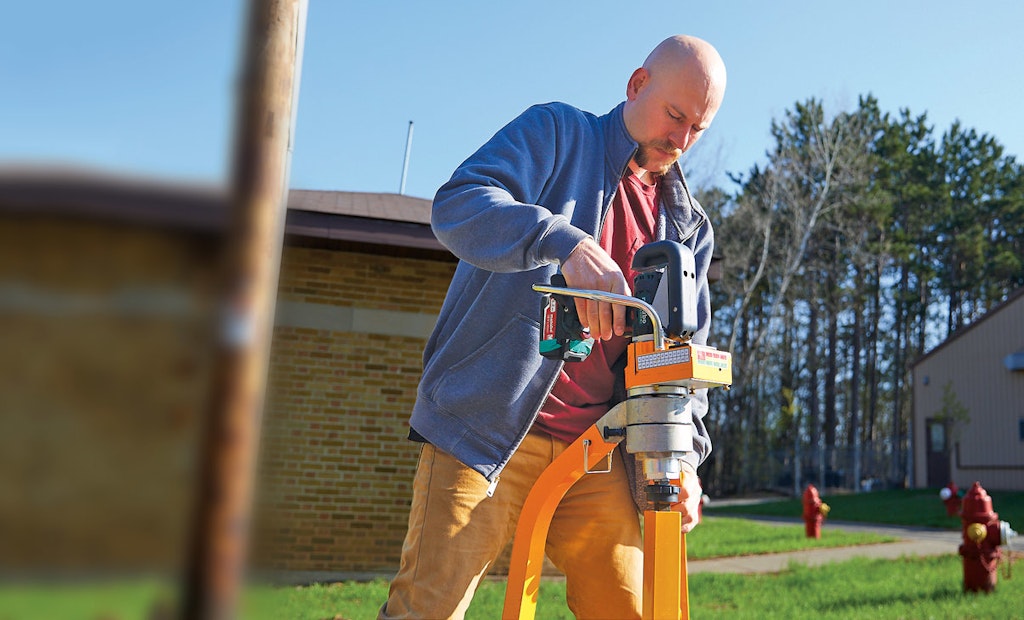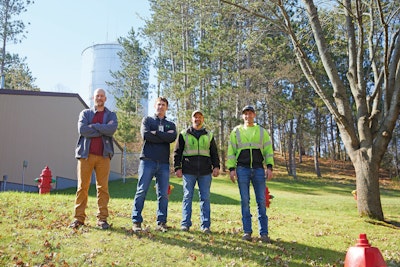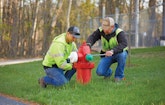
Brian Betts actuates a water main valve. The city’s water system includes approximately 1,000 valves.
Todd Hanson can observe his community’s entire drinking water system from the SCADA screen in his office at the water treatment plant.
At a glance, he knows if the pumps are running normally, knows the water levels in the three towers and the above-ground reservoir, and can detect when something out of the ordinary is happening and needs attention.
That doesn’t mean he and his team members in Sparta, Wisconsin, are armchair operators. The water utility’s three certified operators make rounds to all the wells and storage structures every morning just to make sure all is shipshape. Meanwhile, a regular upgrade program, in place for decades, replaces old piping with brand-new ductile iron mains.
That kind of meticulous care is one reason this city of about 9,500 people in the state’s southwest corner experiences just 2% un-accounted-for water and, on average, just two water main breaks per year. In 2018 the city earned a Small System Excellence Award from the Wisconsin Section of the American Water Works Association.
Hanson, water utility superintendent, is quick to credit the entire city team for the utility’s success. That includes past and current mayors, Public Works directors and city councils who have supported progressive policies, system upgrades and rigorous maintenance. It also includes the members of the water utility staff.
“We have a bunch of hardworking people here,” Hanson says. “They all demonstrate excellence. I know sometimes municipal workers get labeled that they’re just putting in their time. That’s certainly not the case here. It’s been a real sense of accomplishment to see the utility evolve from what it was when I started 32 years ago to what it is today.”
Looking back
All those years ago, Hanson was a dairy farm kid and a high school graduate with studies in groundwater and distribution under his belt from Chippewa Valley Technical College. He started with the Sparta utility as a laborer and quickly applied the work ethic he learned from his parents. He worked his way up the ranks and became superintendent eight years ago.
“All that hands-on training was invaluable,” Hanson says. “In the position where I am now, I can understand all aspects of how the utility is working and how it’s supposed to work.”
At present, Sparta is growing steadily. Some growth consists of commuters to La Crosse, about 25 miles west on the Mississippi River. Some is related to the nearby Fort McCoy U.S. Army training center about 7 miles east.
The water system includes 68.7 miles of mains, 619 fire hydrants and more than 4,100 meters. Caring for that system, along with the 2.25 mgd (design capacity) water treatment plant is the responsibility of Hanson and operators Sam Peterson, Brian Betts and Lee Schwier. All four hold state certifications for groundwater, distribution and iron filtration; Hanson is a state-licensed pump installer. The team also includes Jan Becker, utility billing clerk, and Gail Clark, accountant.
Staying up to date
The water utility’s chief ongoing challenge is the continuous upgrading of the distribution system. “We have about 16 miles of 4- and 6-inch water mains in the system that date back many years,” Hanson says. “We try to do a rehab project every year based on the condition of the facilities. In my 32 years, hardly a summer has gone by that we haven’t torn up a street somewhere to rehab the water, sewer, street pavement, curb, gutter and sidewalk.”
Hanson works with Mark Flock, sewer superintendent, to oversee a five-year upgrade plan. The 4- and 6-inch waterlines are upsized to 8-inch or larger using Class 52 ductile iron piping. Much of the piping being replaced is old sand-cast iron that is brittle, especially at low temperature, and subject to breakage.
“For services, on the city side we specify Type K copper,” Hanson says. “If customers want to go with plastic on their side, that’s their prerogative, but on the city side, it’s all copper up to the curb stop.”
Finding leaks
Main breaks are rare. Hanson estimates that three decades ago, four to six breaks per year were typical: “Now we’re down to two a year. Most communities would think we’re doing something right. We hardly ever see a main that is 30 years or newer break.” Most breaks occur in the sand-cast pipe and in early-generation ductile iron mains installed in the 1970s. The most common cause is freeze-thaw conditions.
Sparta doesn’t electronically monitor for leaks or regularly send crews out with listening devices, although the utility does own a Geophone acoustic leak detector (Pollardwater). Most leaks are noticed when the water surfaces through the area’s sandy loam soil.
The SCADA system also provides clues when breaks occur. “I can look at that daily,” Hanson says. “I know the system, and I can tell if something isn’t right out there. If the pumps on the west side of town have pumped more water and the west reservoir has cycled more than it normally does, then we’re over on the west side investigating. We might reach out to other city staff and say, ‘We think something might be going on in this part of town; if you see something, let us know.’”
Rigorous maintenance
While leaks and repairs are sporadic, maintenance is a year-round affair. From the first of the year through mid-March, Hanson compiles data for the annual Public Service Commission audit. Meanwhile, the staff does maintenance on the pumps, the motors and all equipment related to the city’s six well houses.
“Sprinkled in with that is painting the facilities,” Hanson says. “We have a lot of structures throughout the city, so there is maintenance and upkeep on those buildings. Winter is when we do a good share of that because once spring hits, we’ve got a rehab project going. When we hit April 1, it’s go time.”
Betts spends most of his time in the field doing locates for Diggers Hotline using a Vivax-Metrotech line tracer. He also does the majority of valve exercising, mostly by hand, although he does use a trailer-mounted exerciser (Wachs Utility Products) on older valves that are difficult to turn. In addition, he visits the facilities daily “to check for anything that may be unusual — a sound or a little puddle of water,” Hanson says. “There’s something to be said for being out in the field and seeing things firsthand.”
Peterson performs most of the maintenance on the wells (and the filters at wells 6, 7, 9 and 10). Schwier is largely dedicated to changing meters; about 10% are changed out annually. Since 2011, the city has used a drive-by automated meter reading system (Sensus).
“When I started here,” Hanson says, “the superintendent at that time gave me a notepad and a pencil and said, ‘Go find Kent Street and start reading meters.’ Back then it took three of us one week to read our meters. Now, with technology, one guy reads the meters via laptop in the truck, and it takes about six hours.
“Next for us is advanced metering infrastructure, where we’ll put antennas on a couple of our towers,” he adds. “We have about 900 meters to change with Meter Transceiver Unit boxes compatible to the AMI system. Then we’ll be able to proceed with that step. I foresee it happening in the next few years.”
Flushing, maintenance and repair of the fire hydrants take place in April and October. The city uses just one fire hydrant model to minimize the parts inventory. The water towers and reservoir are inspected by Lane Tank on five-year (half-drained) and 10-year (fully drained) cycles and rehabilitated as conditions warrant.
The extra mile
During maintenance, team members can make refinements to the utility’s infrastructure map. The city worked with engineering firm Mid-States Associates to map the system on GIS. “Our guys have tablets and/or laptops in their trucks,” Hanson says. “So for example, if they see a valve that according to the map runs east but really runs north, they can make the change to the GIS in the field. So we’re getting more accurate each time we do valve exercising.”
Meanwhile, team members strive to deliver excellent service. “If Jan, our billing clerk, notices that water usage seems high at 310 Main St., she’ll red-flag that,” Hanson says. “I pass the work order to my staff and they’ll go talk to that homeowner face-to-face. If the customer wants, they’ll go inside the house. Maybe it’s an elderly person who has a toilet running but can’t hear it — that’s why the bill was $200 instead of $100 for the quarter.”
Good relationships also extend to the city administration. Hanson is careful to keep the mayor, City Council members and other department heads in the loop. At annual goal-setting sessions with the City Council, the department heads list the previous year’s accomplishments, the current year’s activities and the next year’s plans. The department heads meet monthly or bimonthly, usually on the morning after council meetings, to make sure their wishes and the council’s are in alignment.
On the grow
Meanwhile, Sparta keeps growing, and Hanson and his team are preparing for system expansion. The biggest new development is the South Pointe Business Park where phase one streets and utilities are in place and businesses are already moving in. Extension of utilities for phase two is in progress. The growth might call for another water tower. “We’re on top of that,” Hanson says. “We’ve been working closely with Mid-States Associates and getting a game plan in case that should happen.”
Hanson enjoys his job and the support he gets from all quarters: “To succeed, you’ve got to have good people around you, and that’s what we have here in Sparta. My theory has always been: Treat your people like they make a difference, and they will make a difference. I’m blessed to be able to work here for 32 years and I hope many more years before I retire.”
Helping hands
Smaller community water utilities can’t always afford to own all the tools they need to take care of their distribution systems. So they work together, sharing equipment and expertise. The water utility in Sparta, Wisconsin, is a case in point.
Earlier this year, the operations team discovered water bubbling up about 2 feet from the foundation of a house. “When we arrived, we assumed the water service had ruptured before it went through the foundation into the house,” says Todd Hanson, water utility superintendent. “But after we shut the curb stop off, the water didn’t quit. We started valving the main off until we got it isolated and the leak stopped.”
Then it was a question of finding the exact location of the leak, and that’s where cooperation came in. The nearby city of Onalaska owned a correlator from Vivax-Metrotech and gladly lent it to the Sparta team.
“We hooked it up to the pipe and found that the leak was about 40 feet from where the water was bubbling up,” Hanson says. “The correlator mapped the leak to within about 3 feet of where it actually was. That was a really valuable piece of equipment at the time. If we would have just started digging where the water was bubbling up, we would have been there all day and half the night just to chase the leak.”
Sparta and Onalaska had some previous experience in sharing equipment. “During the terrible winter of 2013-14, everybody had their pipes freezing up,” Hanson says. “We had a small Magikist service line thawing unit. We lent that out to Onalaska. They were appreciative of that and in turn they did me a favor.”
Hanson also reaches out to the Wisconsin Rural Water Association for assistance when needed. “I am a member of a WRWA committee, and I work closely with them, as do most utilities in Wisconsin, especially in communities under 10,000 in population. All the communities in this area get along and work together. If someone needs something, we’re always willing to help each other out.”









